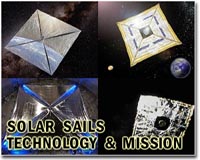 |
Tokyo (AFP) June 11, 2010 Japan said Friday its kite-shaped "space yacht", designed to float through space using only the power of the sun, successfully started sailing with solar power generation. A Japanese rocket last month launched the experimental "Ikaros" -- Interplanetary Kite-craft Accelerated by Radiation of the Sun -- designed to be propelled by the pressure of sunlight particles. The technology could eventually enable space travel without fuel, as long as there is sunlight. Similar to an ocean yacht pushed by wind, the device has a square, ultra-thin and flexible sail measuring 14 metres by 14 metres (46 by 46 feet) that will be driven through space as it is pelted by solar particles. The sail, which was fully expanded Thursday, is only a fraction of the thickness of a human hair and is partly coated with thin-film solar cells to generate electricity. Japan Aerospace Exploration Agency (JAXA) "confirmed the full expansion of the sail and electric generation with thin film solar cells at about 7.7 million kilometres from Earth," it said in a statement. JAXA will continue monitoring and studying "navigation technology using the solar sail", it said. The name alludes to Icarus, the figure from Greek mythology who flew too close to the sun. The space yacht, however, is headed in the direction of Venus. Ikaros, which cost 1.5 billion yen (16 million dollars) to develop, will be the first use of propellant-free technology in deep space, although it has been tested in orbit around the Earth before. JAXA has said the navigation technology "will mark the first spectacular achievement of its kind in the world."
Share This Article With Planet Earth
Related Links Ikaros - JAXA Solar Sail Mission Space Tourism, Space Transport and Space Exploration News
 Japan rocket blasts off with 'space yacht' and Venus probe
Japan rocket blasts off with 'space yacht' and Venus probeTokyo (AFP) May 21, 2010 A Japanese rocket blasted off early Friday and successfully launched a Venus probe and a kite-shaped "space yacht" designed to float through the cosmos using only the power of the sun. The launch vehicle, the H-IIA rocket, took off from the Tanegashima space centre in southern Japan on schedule at 6:58 am (Thursday 2158 GMT), three days after its original launch was postponed by bad weather. ... read more |
|
| The content herein, unless otherwise known to be public domain, are Copyright 1995-2010 - SpaceDaily. AFP and UPI Wire Stories are copyright Agence France-Presse and United Press International. ESA Portal Reports are copyright European Space Agency. All NASA sourced material is public domain. Additional copyrights may apply in whole or part to other bona fide parties. Advertising does not imply endorsement,agreement or approval of any opinions, statements or information provided by SpaceDaily on any Web page published or hosted by SpaceDaily. Privacy Statement |